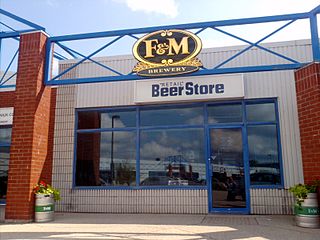
Puslinch is a township in south-central Ontario, Canada, in Wellington County, surrounding the south end of Guelph. The main source of production is agricultural, spring water bottling and mining. Aggregate mining has been dominant throughout the county. About half of the township is forested, and a conservation area lies to the southwest. Near the western edge of the township, just outside Cambridge, Ontario, is Puslinch Lake, the largest kettle lake in North America. It is part of the Guelph census metropolitan area.

Creemore Springs is a brewery in Creemore, Ontario, Canada, which first opened in 1987. It was founded by John Wiggins, and its flagship brew was a premium amber lager brewed with specialty malts, fire brewed in a copper kettle. In 2005, it was acquired by Molson, a subsidiary of the seventh largest brewery corporation in the world, Molson Coors Brewing Company.

Sleeman Breweries is a Japanese-owned Canadian brewery founded by John Warren Sleeman in 1988 in Guelph, Ontario. The company is the third-largest brewing company in Canada. Along with its own Sleeman brands, the company produces under licence the Stroh's family of brands, Maclays Ale and Sapporo Premium beers for sale in Canada. The company's parent Sapporo owns 4.2 per cent of Ontario's primary beer retailer The Beer Store.

Sapporo Breweries Ltd. is a Japanese beer brewing company founded in 1876. Sapporo is the oldest brand of beer in Japan. It was first brewed in Sapporo, Hokkaido, Japan, in 1876 by brewer Seibei Nakagawa. The world headquarters of Sapporo Breweries is in Ebisu, Shibuya, Tokyo. The company purchased the Canadian company Sleeman Breweries in 2006.

Beer was introduced to Canada by European settlers in the seventeenth century. The first commercial brewery was La Brasseries du Roy started by New France Intendant Jean Talon, in Québec City in 1668. Many commercial brewers thrived until prohibition in Canada. The provincial and federal governments' attempt to eliminate "intoxicating" beverages led to the closing of nearly three quarters of breweries between 1878 and 1928. It was only in the second half of the twentieth century that a significant number of new breweries opened up. The Canadian beer industry now plays an important role in Canadian identity, although globalization of the brewing industry has seen the major players in Canada acquired by or merged with foreign companies, notably its three largest beer producers: Labatt, Molson and Sleeman. The result is that Moosehead, with an estimated 3.8 percent share of the domestic market in 2016, has become the largest fully Canadian-owned brewer.

Neustadt is a community in the municipality of West Grey in Grey County in southern Ontario, Canada. The village is located south of Hanover on Grey Road 10 and north of Guelph, Ontario and Kitchener, Ontario. Neustadt is a rural Ontario village with German roots and a village history associated with farming culture. In their April 2000 edition, Harrowsmith Magazine named Neustadt one of Canada's ten prettiest villages as evidenced by the historic 19th century Victorian farmhouses highlighting Gothic Revival architecture. Neustadt has also been featured in Country Living.

Waterloo Brewing LTD. is a brewery based in Kitchener, Ontario, Canada, with several divisions. The company is reportedly the largest Canadian-owned brewer in the province, and it was also Ontario's first modern craft brewery.

Stone Brewing is a brewery headquartered in Escondido, California, USA. Founded in 1996 in San Marcos, California, it is the largest brewery in Southern California. Based on 2020 sales volume it is the ninth largest craft brewery in the United States.

Salem is a compact rural community and unincorporated place in the incorporated township of Centre Wellington, Wellington County, in southwestern Ontario, Canada.
Nethergate Brewery & Distillery, founded in 1986 by Ian Hornsey and Dick Burge, stands as a distinguished microbrewery deeply rooted in Suffolk's rich beer heritage. Born out of dissatisfaction with local brews, the brewery gained acclaim with flagship creations like Suffolk County and Old Growler. A notable resurgence in 2014 under Dick Burge's leadership saw the revival of the community-focused business. Located in Long Melford since 2017, the brewery expanded its facilities and offerings, including the introduction of Venture.

The Pearl Brewing Company was an American brewery established in 1883 in downtown San Antonio, Texas, United States. In 1985, Pearl's parent company purchased the Pabst Brewing Company and assumed the Pabst name.

Steelback Brewery was a Canadian brewery located in Tiverton, Ontario, on the shores of Lake Huron.
The Lakeport Brewing Company was a brewery located in Hamilton, Ontario, Canada. Although it started as a producer of premium beers, it later switched to cheap discount brands, using a strategy of selling its beer for "a buck a bottle". By 2006, it had become the largest discount brewer in Canada. In 2007, Lakeport was taken over by InBev's Canadian subsidiary, Labatt. Three years later, InBev closed the Hamilton brewing plant, and shifted production of Lakeport beers to the Labatt plant in London, Ontario.

Canadian Breweries Limited (CBL), originally the Brewing Corporation of Ontario, was an Ontario-based holding company in the brewing industry. The company was founded in 1930 by a merger of two breweries, Brading of Ottawa and Kuntz of Kitchener-Waterloo. Under the direction of its top executive, E. P. Taylor, the company bought or merged many of the smaller competitors existing after the repeal of prohibition. The new company closed many plants, reduced the number of beer brands and built new, larger plants to produce enough beer for a much larger geographic area. By the 1950s, the company had reduced the number of beer brands from approximately one hundred to six. Canadian Breweries became part of a large conglomerate of manufacturing and consumer businesses controlled by the Argus Corporation in 1945.

The Quinnipiac Brewery, also known as Brewery Square, is a complex of brick buildings at 19-23 River Street in the Fair Haven neighborhood of New Haven, Connecticut. Developed beginning in 1892 and operative until the 1930s, the complex is a rare example of a late 19th-century large-scale brewery. The complex was listed on the National Register of Historic Places in 1983. Most of the complex is now residences.

Littig Brothers/Mengel & Klindt/Eagle Brewery is located in a residential and light industrial area of the west end of Davenport, Iowa, United States. It has been listed on the National Register of Historic Places since 1983.

StoneHammer Brewing was located in Guelph, Ontario and was a member of the Ontario Craft Brewers Association (OCB). The brewery was established in August 1995 as F&M Breweries by Rich Fortnum, Bruce Fortnum, Antonia Smits and Charles MacLean. They produced StoneHammer Pilsner, MacLean's Pale Ale, and a dry-hopped dark mild sold only in casks to select publicans. During this time, F&M started contract brewing in Ontario for a handful of contracts while under contention under LCBO licensing. Their StoneHammer Pilsner was also invited into the Great British Beer Festival beer competition, into the American jurisdiction. Three years later it was sold to Frank Cerniuk who continued the Stone Hammer (sic) name with an award-winning line of Stone Hammer beers under the company name F&M Brewery. In February 2015, Frank sold the Brewery to Phillip and Lesley Woodhouse who renamed the brewery after its flagship brand. In spring 2018, the company filed for bankruptcy having closed its doors in late April of that year. StoneHammer also produced several contract beers, including the Taste of Ontario Harvest Series for the Neighbourhood Group.

San Diego County, California, has been called "the Craft Beer Capital of America". As of 2018, the county was home to 155 licensed craft breweries – the most of any county in the United States. Based on 2016 sales volume, three San Diego County breweries – Stone, Green Flash, and Karl Strauss – rank among the 50 largest craft brewers in the United States. San Diego County brewers pioneered the specialty beer style known as Double India Pale Ale, sometimes called San Diego Pale Ale. Its beer culture is a draw for tourism, particularly during major festivals such as San Diego Beer Week and the San Diego International Beer Competition. San Diego County breweries including Stone Brewing Co., AleSmith Brewing Company and Ballast Point Brewing Company are consistently rated among the top breweries in the world.

The American Brewing Company Plant, owned by the American Brewing Company, is a historic brewery complex at 431 Harris Avenue in Providence, Rhode Island that operated between 1892 and 1922. It is a well-preserved example of a state of the art late 19th century brewery building, its original functions still discernible in its layout. It was only used as a brewery until 1922, when it was shut down by Prohibition; it has served as a warehouse and storage facility for most of the time since. The complex was listed on the National Register of Historic Places in 2016.

Saint Vincent Beer was a dark lager brewed by monks at Saint Vincent Archabbey in Unity Township, Pennsylvania, United States, between 1856 and 1918. Pope Pius IX granted the monks permission to brew in 1852, ending a dispute with the Roman Catholic Diocese of Pittsburgh. The brewery was located in a log cabin near the Saint Vincent Archabbey Gristmill and a brick building supplemented the cabin in 1868. After production ceased, the monastery used the buildings for storage until they burned down in 1926. The walls were removed from the site in 1995 during the restoration of the gristmill.



















